Lynne Hibak holds a broad grin as she sweeps her fingers across an iPad, lighting up swirling streams of colour in the shape of a heart.
For the 32-year-old client of the Garth Homer Society in Saanich, the touch screen offers her entertainment and easy access to the Internet. For other developmentally disabled adults at the day facility, some who can’t speak or with limited movement, the technology has given them an unexpectedly rich voice to the world.
Hibak uses the iPad to research birds and animals she sees while volunteering at Swan Lake Nature Sanctuary. Her friend Laurie Fairweather does the same at her volunteer job Glendale Gardens, a.k.a. the Horticultural Centre of the Pacific.
“My fingers don’t always go where I want. You can make mistakes with the iPad and it's no big deal,” Fairweather says. “If I come across a plant I don’t know at Glendale Gardens I can take a picture (with the iPad) and find it.”
“I research different subjects, like people with different disabilities,” Hibak offers. “I have a disability myself and makes me more aware of other peoples’ disability.”
The iPad and its apps have been so successful in giving creative outlets to Garth Homer clients, the society bought 14 of the devices last fall.
High-functioning clients like Hibak and Fairweather adapted to the iPads quickly, but then so did those with significant developmental impairments. Clients who would normally struggle to pick up small objects can assemble virtual jigsaw puzzles, or paint with their hands or even play musical instruments. Deeply disabled, withdrawn individuals will engage using the iPad, even if just to splash a virtual fish pond.
For clients with autism, people who require and demand strict routines, the iPad allows staff to create visual, individualized schedules using digital photos of the client doing tasks – eating lunch, driving in the van, going to a park. The clearer the routine, the lower the anxiety.
“There wasn’t the confusion or frustration that I was anticipating due to introducing something that is not familiar,” said Rob Baker, a staff member who works with clients requiring a high level of care.
“We have clients with no capability to draw or hold a pen, but they can still use their hands and fingers. All of a sudden they can make art without obstacles. They found uses that I had no idea about.”
Baker had the bright idea to introduce his personal iPad to Garth Homer about a year ago, just to test the level of interest and engagement from people in his program. A few moments using the hands-on device, and clients were hooked.
“The iPad can be whatever we need for our clients. It can be fun, educational, used for schedules. It’s a great blank slate to start with,” Baker says. “It makes a difference in their lives.”
Colina Titus, Garth Homer director of client services, said the more profound the disability, the more impact the technology has on their life. One woman who can’t speak and who has limited motor skills uses images on the iPad to quickly communicate decisions on the day's activities or what she'd like for lunch.
“Clients use it to make choices,” Titus says. “For those who can’t speak, it's a fantastic tool.”
Garth Homer executive director Mitchell Temkin said the society will likely buy more iPads this year and has earmarked money to develop in-house apps for assessing a client’s employment capability.
The 14 iPads bought last year cost about $6,000, funded through wishing fountain coins donated by Butchart Gardens, and other fundraising efforts.
Temkin admits that in the beginning, it wasn’t clear if the iPads would be broadly useful, although now it seems the technology is improving their clients’ quality of life, and allows them to “finger paint their thoughts.”
“We mistake diminished communication capacity with diminished cognitive capacity, and that is completely false,” Temkin says. “The iPad is tearing down communications barriers.”
editor@saanichnews.com
